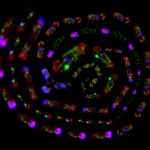Lien vers Pubmed [PMID] – 16532063
PLoS Genet. 2006 Mar;2(3):e32
Hemiascomycete yeasts cover an evolutionary span comparable to that of the entire phylum of chordates. Since this group currently contains the largest number of complete genome sequences it presents unique opportunities to understand the evolution of genome organization in eukaryotes. We inferred rates of genome instability on all branches of a phylogenetic tree for 11 species and calculated species-specific rates of genome rearrangements. We characterized all inversion events that occurred within synteny blocks between six representatives of the different lineages. We show that the rates of macro- and microrearrangements of gene order are correlated within individual lineages but are highly variable across different lineages. The most unstable genomes correspond to the pathogenic yeasts Candida albicans and Candida glabrata. Chromosomal maps have been intensively shuffled by numerous interchromosomal rearrangements, even between species that have retained a very high physical fraction of their genomes within small synteny blocks. Despite this intensive reshuffling of gene positions, essential genes, which cluster in low recombination regions in the genome of Saccharomyces cerevisiae, tend to remain syntenic during evolution. This work reveals that the high plasticity of eukaryotic genomes results from rearrangement rates that vary between lineages but also at different evolutionary times of a given lineage.



